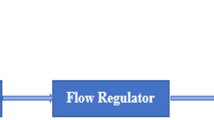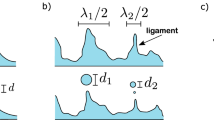Abstract
Purpose. Empirical formulae relate the mean size of primary droplets from jet and ultrasonic nebulizers to a fluid's physicochemical properties. Although the size selective “filtering” effects of baffling and evaporation may modify the secondary aerosol produced, this research sought to evaluate whether viscosity and surface tension of nebulized fluids influenced the aerosol's size and output characteristics.
Methods. Fluid systems of different surface tension and viscosity (glycerol and propylene glycol solutions [10–50% (v/v)] and a range of silicone fluids [200/0.65 cs– l00cs]) were nebulized in three jet and two ultrasonic nebulizers. Secondary aerosol characteristics were measured with a Malvern 2600C laser diffraction sizer and the nebulization times, residual volumes and percentage outputs were determined.
Results. While the droplet size appeared to be inversely proportional to viscosity for jet nebulizers, it was directly proportional to viscosity for ultrasonic nebulizers. Although fluid systems with lower surface tensions generally produced slightly smaller MMDs, the relationship between surface tension and droplet size was complex. The more viscous fluids required longer nebulization times and were associated with increased residual amounts (lower outputs). The ultrasonic nebulizers did not effectively, and were on occasion unable to, nebulize the more viscous fluids.
Conclusions. It follows that there are cut-off values for viscosity and/or surface tension above or below which ultrasonic devices fail to operate. Moreover, jet nebulizers generated an aerosol with an optimum respirable output from median-viscosity fluids.
Similar content being viewed by others
REFERENCES
A. A. Rizkalla and A. H. Lefebvre. Influence of liquid properties on air-blast atomizer spray characteristics. ASME Gas Turbine Conference Paper No. 74-GT-1, 1–5 (1974).
T. T. Mercer. Production of therapeutic aerosols. Chest 80:813–817 (1981).
E. M. Searls and F. M. Snyder. Relation of viscosity to dropsizes. J. Econ. Entomol. 29:1167–1170 (1936).
R. G. Dorman. The atomization of liquids in a flat spray. Br. J. Appl. Physiol. 3:189–192 (1952).
D. Hasson and J. Mizrahi. The drop size of fan spray nozzles. Trans. Instn. Chem. Engrs. 39:415–422 (1961).
W. C. Hinds, J. M. Macher, and M. W. First. Size distribution of aerosols produced by the Laskin aerosol generator using substitute materials for DOP. Am. Ind. Hyg. Ass. J. 44:495–500 (1983).
W. Walkenhorst and L. Dauterbande. New studies on aerosols, 23 Experimental observations on various factors influencing weight, number, flow-rate and size distribution of aerosol particles. Arch. Int. Pharmacodyn. 150:264–294 (1964).
V. I. Kouchetov, E. S. Klepikov and R. M. Garaishin. Effect of surface active agents on spraying of a liquid. Colloid J. USSR 27:203–206 (1965).
V. B. Fainerman and V. S. Sapiro. Dispersion of aqueous surfactant solutions by air-atomizing nozzles. Colloid J. USSR 35:392–394 (1973).
S. S. Davis. Physico-chemical studies on aerosol solutions for drug delivery. 1. Water-propylene glycol systems. Int. J. Pharm. 1:71–83 (1978).
S. P. Newman, P. G. D. Pellow, and S. W. Clarke. Dropsizes from medical atomisers (nebulizers) for drug solutions with different viscosities and surface tensions Atomization and Spray Technol. 3:1–11 (1987).
R. J. Lang. Ultrasonic atomization of liquids. J. Acoustic Soc. Am. 34:6–8 (1962).
K. Sollner. The mechanism of the formation of fogs by ultrasonic waves. Trans. Faraday Soc. 32:1532–1536 (1936).
E. L. Gerhenzon and O. K. Eknadiosyants. The nature of liquid atomization in an ultrasonic fountain. Sov. Phys. Acoust. 10:156–162 (1964).
B. I. II'in and O. K. Eknadiosyants. Nature of liquid atomization in an ultrasonic fountain. Sov. Phys. Acoust. 12:310–318 (1966).
Y. Y. Boguslavskii and O. K. Eknadiosyants. Physical mechanism of the acoustic atomization of a liquid. Soviet Phys. Acoust. 15:14–21 (1969).
R. M. G. Boucher and J. Kreuter. The fundamentals of the ultrasonic atomization of medicated solutions. Ann Allergy 26:591–600 (1968).
O. A. Kapustina. Effect of surface active substances on bubble growth kinetics in a sound field. Soviet Phys. Acoust. 15:110–111 (1969).
A. R. Clark. The use of laser diffraction for the evaluation of the aerosol clouds generated by medical nebulizers. Int. J. Pharm. 115:69–78 (1995).
M. M. Clay, D. Pavia, S. P. Newman, and S. W. Clarke. Factors influencing the size distribution of aerosols from jet nebulizers. Thorax 38:755–759 (1983).
S. P. Newman, P. G. D. Pellow, and S. W. Clarke. In vitro comparison of DeVilbiss jet and ultrasonic nebulizers. Chest 92:991–994 (1987).
Author information
Authors and Affiliations
Rights and permissions
About this article
Cite this article
McCallion, O.N.M., Taylor, K.M.G., Thomas, M. et al. Nebulization of Fluids of Different Physicochemical Properties with Air-Jet and Ultrasonic Nebulizers. Pharm Res 12, 1682–1688 (1995). https://doi.org/10.1023/A:1016205520044
Issue Date:
DOI: https://doi.org/10.1023/A:1016205520044




